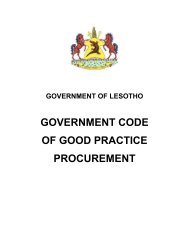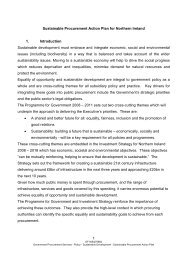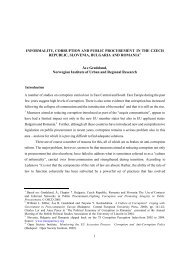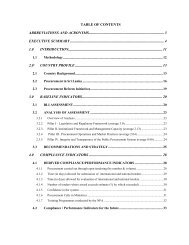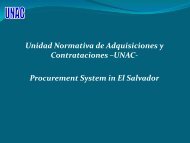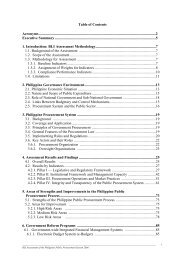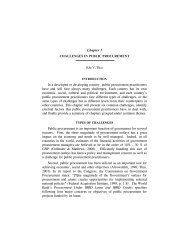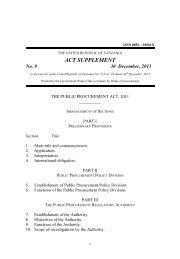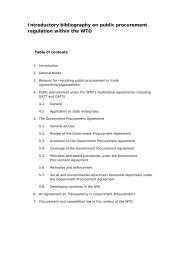Green Public Private Partnerships - unpcdc
Green Public Private Partnerships - unpcdc
Green Public Private Partnerships - unpcdc
Create successful ePaper yourself
Turn your PDF publications into a flip-book with our unique Google optimized e-Paper software.
Contents• Introduction ....................................................................................................................................1• Key messages..................................................................................................................................2• Some definitions ..........................................................................................................................4One PPPs and greening ..........................................................................................................................6Two Have you considered your green policy and is it relevant? ............................12ThreeEC procurement issues..............................................................................................................15Four Writing the output specification ........................................................................................18Five Refining the business case ......................................................................................................21Six Selection of bidders and evaluating the bids ............................................................23Seven Delivering the benefits ..............................................................................................................26Annex A Issues for contractors to consider when drawing up their tender......29Annex B Further advice and information..................................................................34
IntroductionWho should read this guidance note?Anyone who is developing or managing a public private partnership,including private finance initiative projects, and other significantpublic procurements involving capital investment. It providespractical help to assist you to green your scheme.Why should you read it?By taking account of relevant environmental considerations you canachieve significant additional benefits and possible savings.What does this guidance contain?It explains why you need to take green issues seriously and how bestto reflect legitimate environmental considerations in the objectives ofa scheme. It also points you to sources of advice and practical help.Surely EC procurement directives rule out specifying green criteriaNot at all, you just have to be clear about what you want.It can’t be that easyIt can. By following a few simple steps from the start, you canachieve value for money, deliver a much better scheme and at thesame time reduce waste and improve the environment. It’s a winwinopportunity.Read on!In addition to straightforward practical advice this document alsoincludes examples of projects where the decision to take account ofthe green agenda will deliver value for money over their 25-30 yearlifetimes.1
Key MessagesIntroductionKey Messages• Take the long term view – Remember the whole life cost of theproject and specify the outcome you wish to achieve.• Failure to consider green issues when developing a PPP/PFIproject, means you can miss a once in a lifetime opportunity toreduce the whole life costs, since the contract may run for 25-30 years; but potentially even longer given the asset life.• <strong>Green</strong>ing and private finance are not mutually exclusive. On thecontrary they both look at the service to be provided and thewhole life costs of doing so – being green is about eliminatingwastefulness.• Be clear about your organisation’s strategy for sustainabledevelopment and its environmental policies and how far theycan be delivered through the project.• Buying green only costs less if you get it right – get it wrongand it may cost more. But you can also decide to spend more toget better quality.• Be careful what you specify and be careful about what you arebeing offered – is it as green as it claims to be and does itdeliver value for money.• Remember the EC procurement rules – be clear about what it isacceptable and what is not when specifying outputs, selectingbidders and awarding contracts.2
Key Messages• Always focus on value for money and not the lowest cost.• <strong>Green</strong>ing doesn’t just stop with the award of the contract – yourorganisation will need to work with suppliers to ensureimproved environmental performance throughout the life of theproject.• The policy and regulatory framework for the environment islikely to be toughened over time. In some cases this mightinvolve change of law provisions within the signed PPPcontract.3
Some definitions4Some definitionsPPP: <strong>Public</strong> <strong>Private</strong> <strong>Partnerships</strong> bring public and private sectorstogether in long term partnership for mutual benefit. The PPP labelcovers a wide range of different types of partnership including the<strong>Private</strong> Finance Initiative, the introduction of private sectorownership into state-owned businesses and selling Governmentservices into wider markets and other partnership arrangementswhere private sector expertise and finance are used to exploit thecommercial potential of Government assets. The full range of PPPsis explained in the Treasury publication <strong>Public</strong> <strong>Private</strong> <strong>Partnerships</strong> –The Government’s Approach.PFI: The <strong>Private</strong> Finance Initiative (PFI) is a procurementmechanism by which the public sector contracts to purchase qualityservices on a long term basis so as to take advantage of privatesector management skills incentivised by having private finance atrisk. This includes concessions and franchises, where a private sectorpartner takes on the responsibility for providing a public service,including maintaining, enhancing or constructing necessaryinfrastructure.<strong>Green</strong>ing Government: Is the process of integrating sustainabledevelopment and environmental considerations into decision makingat all levels across government. The term “Sustainable Developmentin Government” is now preferred as it more accurately reflects thework of <strong>Green</strong> Ministers.Sustainable Development: Ensuring a better quality of life foreveryone, now and for generations to come – that is social progress,protection of the environment, prudent use of natural resources andeconomic growth – all at the same time.Value for money: The Government’s procurement policy is that allpublic procurement of goods and services, including works, is to be
Some definitionsbased on best value for money – the optimum combination of wholelife cost and quality to meet the requirement.EC procurement rules: Shorthand for the EC Treaty,Procurement Directives, and the UK Regulations that implementthem, and case law. Procurement Directives apply to mostpurchasing contracts let by the public sector where the valueexceeds certain thresholds, and they include detailed requirementsfor specifications, selection of candidates and award of contracts.The government policy and the EC rules are known collectively as“the policy and legal framework”.Environmental Management System: Is the structure,responsibilities, practices, procedures, processes and resourceswhich enable an organisation to continuously improve itsenvironmental performance.Environmental Policy: Is a publicly available documentcommitting a public authority to an understanding of itsenvironmental impacts and achieving continuing improvementthrough setting objectives and targets.5
1 PPPs and greeningWhy PPP and environmental objectives?1.1 The essence of PPP and <strong>Private</strong> Finance Initiative contracts is thatthey place the risks with the party best placed to manage them thusensuring best value for money. Traditional public procurement canbe characterised by separate contracts being let for construction,maintenance and facilities management. The long term andintegrated nature of PPP service contracts incentivises thecontractors to consider the synergies between the design of an assetand its ultimate operating costs. This can result in the delivery ofpublic services in a more environmentally sensitive way and withoutan additional price tag.Whole life costing1.2 Treasury rules require that PPP and PFI projects demonstrate thatthey achieve value for money based on the appropriate transfer ofrisk to the private sector. Value for money is defined by Treasury as“the optimum combination of whole life cost and quality (or fitness forpurpose) to meet the user’s requirement”.1.3 The emphasis on whole life costs means that public sectorcontracting authorities are required to take account of all aspects ofcost, including running and disposal costs, as well as the initialpurchase price of an asset. The reference to “quality to meet thecustomer’s requirement” enables contracting authorities to specifywhat they need to do to meet their own operational and policyobjectives while contributing to the Government’s objectives onenvironmental matters. Contracting authorities must, of course,satisfy themselves that specifications are justifiable in terms of need,cost effectiveness and affordability.1.4 The contractor, which may be a consortium, for a public privatepartnership has a financial motivation for considering which design6
SECTION ONEfeatures and construction materials will generate optimum whole lifecosts across the life of the contract. This might mean a contractorchoosing to invest in higher cost design features if those features willbe offset by lower maintenance and running costs during theoperational life of a contract and beyond.<strong>Green</strong> features reduce whole life costs1.5 Environmental considerations, set out in documents such asenvironmental policies, are intended to help achieve theGovernment’s objective of a more sustainable environment, which isa government objective. Many of these considerations can also havea positive impact on the operation of a project. Whilst requiringmaterials such as timber to come from legal and sustainablymanaged sources is a good aim in itself, an efficient heating systemfor an office building can both help to reduce carbon dioxideemissions and energy usage (two high level environmentalobjectives) and result in lower whole life costs for the contractor.1.6 There is a problem of perception that environmental technologiesand materials are an expensive luxury that government can notafford. This is clearly wrong. PPP projects have demonstrated thatinvesting to deliver environmental improvements can secure notonly best value for money through lower running costs but alsohealth and social benefits such as better working conditions. Theadoption of green outputs can also help to accelerate thedevelopment and take-up of green technologies – a sector ofgrowing importance to the UK economy.7
Good design can deliver whole life andenvironmental benefitsGood design is crucial to the success of a project and shouldachieve savings in whole life costs and improvements inenvironmental performance and productivity. In addition welldesigned public buildings can help deliver wider benefits to thecommunities where they are located (as set out in the Better<strong>Public</strong> Buildings document produced by OGC/DCMS). Toenable good design there should be a clear and concisestatement of output requirements that includes the values andevaluation criteria to be employed. Sufficient time must beallowed to enable full and proper consideration of theserequirements. There also needs to be a commitment from boththe service provider and contracting authority to achievequality objectives such as reducing the use of energy, water andother resources, minimising waste and controlling pollution.Bidders will need to consider the following issues in developinga PPP proposal:• minimising waste.• reducing whole life costs – by optimising the balancebetween initial costs and maintenance and operating costswithout compromising user comfort.• enhancing service delivery – a building which is well litand airy, relying on natural light, can positive effects onusers with obvious benefits to productivity.• promoting wider social and environmental benefits –by addressing health, safety and environmental concerns ofthose living and working in the area a project can have asignificant impact on improving the morale and well beingof the community.• encouraging in-built flexibility – by enabling the facilityto save time and cost in the delivery of new services and torespond efficiently to changing requirements and newtechnologies particularly those which can conserveresources and reduce waste.8
SECTION ONEProject objectives1.7 In establishing a project it is important to be clear about whatenvironmental objectives are to be delivered. The addition of greenrequirements to the project specification at a later date willinevitably require the project to refocus around the new overallrequirement which may have cost implications and lead to problemsunder the EC rules.1.8 High level questions to ask about the project might include:• Are there any key environmental objectives for the project, andare these represented in the Project Initiation Document?• Are there any environmental factors which will affect theintended project’s output or outcome, and are these representedin the key performance indicators (KPIs) for the project?• What real or potential environmental risks are there to the successof the project, and how might these be ameliorated in the projectrisk register? Who is best placed to manage these risks?1.9 On a more practical level, the following issues might be consideredin drawing up the outline business case for a project:• Is there a better way of achieving the same ends? For example,localised satellite offices with hot-desking and tele-working maybe a more cost-effective, environmentally preferable and sociallybeneficial alternative to a large office in a prime inner citylocation.• Is there an opportunity to reduce unused space and maximisethe use of ‘brown’ land across the estate?• Which design and construction processes might be influenced(eg designing in energy efficiency, minimising the primary materialsused, ensuring end-life recycling of materials, use of ‘greywater’)?How should these be reflected in the output based requirement.• How might the requirements of departmental travel plans beincluded. For example, by requiring any new buildings orrelocation to be at sites already well served by public transportto reduce vehicle emissions.9
The project team1.10 The project team needs to reflect the full range of skills necessary totake the project through to contract signature.• It is advisable to appoint an environmental champion at theproject’s inception who will sit on the project board – this mightbe a project board member already representing a key group ofstakeholders. Alternatively it might be someone solely selectedto oversee the environmental aspects of the project. It isimportant that there is ownership of the environmental issuesassociated with a project at a suitably high level.• The project team will inevitably require technical advice atvarious stages, such as the preparation of contractdocumentation and the assessment of tenders. It is importantthat any technical advisor appointed by the contractingauthority is able to identify suitable requirements which canhelp ‘green’ the project and assess any environmental claimsmade by bidders (see section 6).Preparing a green PPP procurement1.11 Some “dos” and “don’ts” for creating successful green PPPs:Do draft an output specification which focuses on ends ratherthan means. A suitably open specification should emphasise theneed for good design that is efficient, functional, structurallysound, flexible, sustainable and responsive to the localenvironment. This is covered in more detail in section 4.Don’t go for lowest price. The requirement in the public sectorto achieve value for money for the tax payer means lookingbeyond initial price to take account of whole life costs andquality. A low cost design may result in high maintenance andoperating costs as well as environmental impacts.Do explain in the output specification any legal requirementswhich may affect the design or govern how the services are tobe provided, for example, statutory performance standards,requirements for components or manufacturing techniques.Do use electronic media to avoid use of unnecessary paper inthe procurement process itself.10
SECTION ONECase Study: Inland Revenue – Manchester OfficeRationalisationIn 1995 the Inland Revenue (IR) embarked on a project torelocate 2000 staff from 11 buildings in the Manchester area toa single site. By August 1998 they had all moved into new fullyserviced offices in Manchester City Centre, as a result of a£140m PFI project awarded to London & Regional Properties.The contract will run for 20 years.The IR’s primary objective was to obtain replacement servicedoffice accommodation in central Manchester at optimal cost.However, in specifying its requirement the IR required all thebidders to comply with the Inland Revenue <strong>Green</strong> Guide. Thesuccessful scheme involved a building that was naturallyventilated (i.e. no air conditioning), lighting that switched itselfoff when people left, gas-fired heating with individualthermostatically controlled radiators, double glazing, buildingmaterials from sustainable sources and building managementsystems that monitored the use of resources.11
2 Have you considered yourgreen policy and is it relevant?2.1 <strong>Public</strong> projects are increasingly being scrutinised by <strong>Green</strong>Ministers and stakeholders such as the Environmental AuditCommittee, non-governmental organisations and the public. Toensure they take proper account of environmental and othersustainable development issues it is essential that they reflectGovernment commitments and departmental aims and objectives.2.2 There is no overall checklist for projects and this guidance does notpropose to offer an exhaustive list of issues for consideration,however, a number of the key issues and considerations are set outin Annex A. All projects are different, even those where acontracting authority has a programme of similar projects, such asthe Highways Agency and HM Prison Service. However, wherethere is a programme of projects there is an opportunity to developan environmental strategy and checklist for new projects.Key guidance2.3 The main sources of guidance to be referred to in developing apublic private partnership which can help achieve an outcome withlower whole-life costs and environmental benefits are:• Framework for Sustainable Development on the Government Estate• Achieving Sustainability in Construction Procurement• <strong>Green</strong> Guide for Buyers• Joint HM Treasury/DETR (now DEFRA) note on EnvironmentalIssues in Purchasing12
SECTION TWO• Framework for Sustainable Development on the Government EstateGovernment departments already have strategies for greening theiroperations based on the Model Framework for <strong>Green</strong>ing GovernmentOperations in place for conserving energy, water and other resources,minimising waste and controlling pollution. These will be developedfurther with the introduction in 2002 of the new Framework forSustainable Development on the Government Estate.The contract specification for a PPP project should accord with theaims, objectives and targets contained in any relevant departmentalstrategies. The PPP contract should ideally be sufficiently flexible totake account of any new targets and future monitoring andreporting requirements which may develop over the lifetime of theproject.• Achieving Sustainability in Construction ProcurementThis guidance was published by the Government ConstructionClients’ Panel in June 2000 and places targets on Governmentdepartments to achieve: value for money on the basis of whole lifecosts; high BREEAM assessments; less waste; energy and waterefficiencies that meet at least current best practice for constructiontype; enhancement of biodiversity; less pollution; betterenvironmental management and improved health and safety onbuilding sites; better working environment and increasedproductivity; increased engagement with local communities as partof the decision making process; and improved industry performanceagainst Egan targets.• <strong>Green</strong> Guide for BuyersThis guide was revised in February 2000 and sets out the rules tobe followed when specifying contractual requirements in greenterms. The requirements must, for example, be included in thetender, be relevant to the contract and, where appropriate, refer torelevant European standards and specifications. It also covers wholelife costs, resource efficiency and best practice.The guide also contains a series of action sheets useful to helpbuyers in specific areas such as construction, energy efficiency,hazardous substances, transport, waste, water and wood.13
• EC and Procurement Policy IssuesAuthoritative guidance is given in the Treasury-DETR noteEnvironmental Issues in Purchasing and in the CommissionInterpretative Communication on environmental considerations inpublic procurement (COM(2001) 274 Final). Details of how togain access to these and other sources of useful guidance are set outin Annex B.Remain alert to new guidance2.4 The Government issues environmental guidance from a variety ofdifferent departments, agencies and other sponsored bodies. It is notenough to take account of the present position, a long term PPPshould be flexible to future needs. Whilst there is no single source ofenvironmental information, the Framework for SustainableDevelopment on the Government Estate gives a clear steer togovernment commitments, objectives and targets. The Frameworkwill be published on the <strong>Green</strong>ing Government web site (given inAnnex B).BREEAM (Building Research EstablishmentEnvironmental Assessment Method) – September 1998BREEAM is a tool used to assess the environmental impact ofbuildings and is a requirement of all new government buildingsand major refurbishments. BREEAM 98 provides a flexibleassessment method valid throughout the life of a buildinggiving emphasis to issues of growing environmentalimportance such as transport, water consumption andconstruction materials. BREEAM 98 includes a <strong>Green</strong> Guideto Specification and an environmental profiling system forbuilding materials and components. <strong>Green</strong> Ministers requireenvironmental assessments using BREEAM or equivalent of allprojects to achieve at least “excellent” ratings for new buildings14
3 EC procurement issues3.1 The EC public procurement directives provide plenty of scope forreflecting environmental considerations in procurement. Projectteams should ensure that they conform to the rules, which aredesigned to ensure that public procurement is carried out on thebasis of transparency, non-discrimination and competitiveprocurement Project teams considering the inclusion ofenvironmental issues should pay particular attention to the ECprocurement rules at the following key stages:• Drafting the contract specification• Selecting bidders• Evaluating tenders and awarding the contract• Drafting contract conditions3.2 In considering green requirements there are some “dos” and“don’ts” to ensure that a project is compliant with the ECprocurement rules:Do ensure that contract specifications are non-discriminatory,allow for equivalent means to meet the underlying requirementand adhere to the rules on technical specifications set out in thedirectives;Do, in the absence of European, international, or other relevantstandards covering the required environmental aspects, orwhere a higher level of environmental protection is required,consider defining specifications in line with Eco-label criteriaand indicate that products having Eco-label certificates aredeemed to comply with the requirement. Allowance must bemade for means, other than the Eco-label certificate itself, todemonstrate the required performance;15
Do consider the inclusion of environmental managementschemes (ISO 14001 and EMAS) as a relevant measure ofproof of technical capability. However, in order to be relevant,the management scheme should provide evidence relevant tothe subject or performance of the contract.3.3 Some pitfalls to avoid when employing green considerations in aproject procurement are:• Confusing the criteria used for the selection of bidders and theaward of a contract. Selection criteria relate to the companywhile award criteria relate to the product or service beingprocured. If a potential contractor has been selected to tenderfor a contract because they satisfied a particular technicalrequirement, that requirement cannot normally be used againwithin the contract award criteria.• Including requirements which go beyond the subject orperformance of the project. A requirement for a contractor toconform to a procuring authority’s environmental policy mightconstitute such an example if the environmental policy includesrequirements not relevant to the subject or performance of theproject.3.4 The best way of ensuring that the inclusion of green considerationsconforms to the requirements of the EC procurement rules is bygiving thorough consideration to the requirements at the project’sinception and the subsequent procurement strategy. Anenvironmental impact assessment might be carried out at the timethe business requirement is being identified. It should then bepossible to identify the various costs associated with the green issuesand implement a strategy for taking appropriate consideration ofthese issues in:• the contract specification and contract conditions;• the drafting of the OJEC notice;• the criteria for selecting bidders; and• the evaluation of tenders and award of the contract.16
SECTION THREEEuropean Commission Interpretative Communication ongreen procurement (2001)• This Communication clarifies how, under the existingpublic procurement directives, environmental issues may betaken into account. The Communication does not proposechanges to the directives. It explains that, amongst otherthings:• contracting authorities are free to define the subject of thecontract in an environmentally sound way;• contracting authorities have a great deal of freedom todefine the contract specifications in green terms, providingthey are non-discriminatory and adhere to therequirements, in the procurement directives, on the use oftechnical specifications;• specifications can include production processes – whethervisible or invisible – which contribute to the characterisingof the products. Examples given include: organically grownfoodstuffs and “green” electricity;• in certain circumstances, specifications can be defined inline with Eco-label criteria – with Eco-label certificatesproviding proof of compliance with the particularrequirement. But, other means to demonstrate the requiredperformance must be allowed for;• environmental management schemes (ISO 14001 andEMAS) can be a relevant means of proof of technicalcapacity where it provides evidence relevant to the subjector performance of the contract;• environmental factors can be taken into account at theaward stage, where they are relevant to an assessment ofwhole life costs or quality, and are of economic benefit tothe contracting authority.The interpretative document can be found onhttp://simap.eu.int/EN/pub/src/welcome.htm17
4 Writing the outputspecification184.1 The contract specification for a public private partnership affordsthe opportunity and freedom to potential contractors to proposeinnovative solutions which integrate the design, construction,operation and maintenance of a new or existing public facility. Itshould be expressed in terms of the service outputs and outcomesrequired rather than a tightly specified list of inputs. In some cases,the main outputs of projects may be green objectives, for exampletargets for recycling and composting in PFI projects for wastemanagement. The specification should be sufficiently tight to ensurecompliance with what is required but not so explicit that itdiscourages innovative solutions that offer good value for money. Agood specification will:• focus on the outputs required rather than the means of deliveryand encourage bidders to use their skills and experience todevelop innovative technical solutions and provide the capitalinvestment required to maximise cost savings and improveservice quality – including environmental performance.• be sufficiently broad to allow value to be added by the contractor(but not so broad as to allow bidders to feel exposed to risks thatare difficult to quantify and, consequently, inflate their price).• build in flexibility. It is important that there is flexibility in thedesign of a PPP facility as usage may change over the 25 – 30year life of the contract. Flexible designs save time, money andresources in the long term.• take account of the aims, objectives and relevant targets forimproving environmental performance set out in the newFramework for Sustainable Development on the Government Estate(see section 5), departmental policies and advice on best practice.• take account of legal requirements specific to Ministers andDepartments to safeguard the environment. For example, the
SECTION FOURCountryside and Rights of Way Act 2000 introduced a statutoryduty on all Ministers, Government departments and theNational Assembly for Wales to have regard to the conservationof biological diversity in the exercise of their duties.• take account of market soundings about what industry cansupply.Considerations when writing the specification4.2 Some key “dos” and “don’ts” to ensure that a specification accordswith departmental environmental objectives include:Do read Chapter 22 of Government Accounting (on theGovernment’s procurement policy), the Joint Treasury/DETRnote, the Commission’s interpretative document onEnvironmental issues under the procurement rules and CUP 51on the EC procurement rules.Do take account of the departmental environment strategy andany targets therein.Do make full use of the flexibility afforded under theprocurement policy and legal framework.Do consider the whole life costs and quality of a project.Do take account of the specific advice in section 3 of the <strong>Green</strong>Guide for Buyers (see Annex B).Do ensure that government commitments to sustainabledevelopment are taken account of in the PPP/PFI scheme.Useful information can be found on the <strong>Green</strong>ing Governmentweb site.Don’t just look for lowest cost in commissioning the project..Do express the requirement genuinely in terms of outputs andindicate the expected links between design and construction andthe finished asset’s running costs and environmental outputs.19
<strong>Green</strong> Guide for BuyersThis guidance provides a useful checklist of issues for writingcontract specifications. Key points include:• Build in criteria used to identify environmentally preferableproducts and services.• Take account of measurable environmental performanceindicators.• Take account of any new or evolving legislation onenvironmental standards.• Take account of stakeholders, including any departmentalenergy and environmental managers, potential suppliersand consultants – who can advise on objectives, constraintsand new thinking applicable to the project.• Require bidders as part of their method statement, toexplain how they will comply with the environmentalrequirements in the specification. This might involvepreparation of an environmental impact assessment bybidders of their proposed work.The <strong>Green</strong> Guide for Buyers can be found at:http://www.defra.gov.uk/environment/greening/greenpro/greenbuy/ index.htm20
5 Refining the business case5.1 Throughout the PPP project the project team will be expected todevelop and maintain a business case. The final business case willpresent all the relevant information which will enable a decision tobe made about a contract award. The business case will thereforeneed to take account of the environmental requirements of theproject, and in its final form to provide an assessment of thepreferred option with appropriate commentary.5.2 The business case should demonstrate that any specifiedenvironmental standards are reasonable, achievable and costeffective. It will also need to present any cost assumptions relating toa public sector comparator for the project. The inclusion of greentechnologies in what might appear to be higher up front capitalcosts will need to be explained in terms of their cost effectivenessover the lifetime of the contract and the environmental benefits theydeliver.5.3 During the development of the business case it is important toidentify key stakeholders with environmental interests and those whoneed to be consulted on such matters. The project team might wishto involve outside advisory bodies such as BRECSU, and technicaladvisors.5.4 The business case should reflect the departmental strategy forsustainable development and environmental policies (useful sourcesof information for this are set out in section 5). It should also takeaccount of any environmental cost compliance exercise carried outin accordance with your department’s policy.21
Watermark – Saving water and moneyWatermark is a government-wide project managed by OGCBuying.Solutions to conserve water and thereby reduce thecost of water services paid by the public sector (which spendssome £600 million a year). Organisations which join thescheme are asked to provide data, which is made available viaan on-line database that allows managers to compare waterusage of similar types of building. One early success came fromHM Treasury, Parliament St London, whose annual water billof £40,000 was reduced to £14,000 after participation in theWatermark scheme.More information can be found at: http://www.watermark.gov.uk22
6 Selection of Bidders andEvaluating the Bids6.1 The selection of bidders and evaluation of their bids allows anopportunity to examine the abilities of the firms and how they haveresponded to the environmental requirements within the specification.6.2 In selecting bidders, contracting authorities might choose to look for:• environment management schemes (ISO 14001 and EMAS) asa relevant proof of technical capacity where they provideevidence relevant to the subject or performance of the contract;• a proven record in environmentally conscious design,construction or service provision (as the case may be) withexperience of similar projects;• a grasp of the contribution that a good, integrated team(comprising environmental champion, architects, engineers,designers) can make to meeting the project’s aspirations.6.3 The evaluation methodology for the contract will need to both testthe compliance of bids to the specification as well as giveproportionate weight to the importance of the various criteria beingevaluated. The evaluation process may therefore include a specificconsideration of how the bidder is proposing to handle variousenvironmental issues set out in the specification.6.4 Project teams should be looking for bidders to demonstrate that theyhave understood the needs of the site and that they have the abilityto develop appropriate solutions which meet any requirements toconserve resources, minimise waste and reduce pollution bothduring construction and during the life time of the project.6.5 The final evaluation of tenders should not be based on initial pricealone. It should also take into consideration whole life costs, quality,deliverability, flexibility, management and apportionment of risk,innovation, increases in productivity and other relevant factors.23
6.6 The evaluation methodology should be clear about how the costsand benefits of proposals are to be measured and also about who isto carry out the assessment of the bid proposal, including anyenvironmental claims. This might be suitable work for technicaladvisors, or for departmental energy and environmental managers.6.7 The evaluation team will need to ask “do the green claims made bybidders make sense, satisfy the specification, and do they offer anythingmore?” The advice given in this guidance note and on the greeninggovernment web site, such as the Government’s <strong>Green</strong> ClaimsCode, should help to answer these questions.The <strong>Green</strong> Claims CodeThe <strong>Green</strong> Claims Code provides advice about environmentalclaims made by contractors which are not substantiated as well asclaims for products or environmental marks which have no formalrecognition. Some typical examples to watch out for include:Contains no XBiodegradableEnvironmentallyfriendly or Madewith care for theenvironmentWhere no products of this type any longercontain X, or X is in any case prohibited by law.Meaningless if not explained. An item mightbiodegrade in 5 days or may take severalyears with the right conditions.Meaningless if not explained. Does notnecessarily qualify the whole product as beingenvironmentally preferable if it applies to onlyone aspect of the product’s production.The <strong>Green</strong> Claims Code can be found at:http://www.defra.gov.uk/greening/greenpro/greenpro.htm.6.8 Finally, the EC procurement rules require contracting authorities toprovide feedback if requested by unsuccessful bidders. There willtherefore be an opportunity to comment on the environmentalaspects of their proposals and how these were evaluated. Suchfeedback should help to transform the market into taking greateraccount of environmental considerations.24
SECTION SIXCase Study: Ministry of Defence Colchester Garrison –the provision of accommodation and office services(expected to reach financial close in 2002)Colchester is home to one of the Army’s largest traininggarrisons. In 1996 the Ministry of Defence decided to take thePFI route to upgrade the serviced accommodation and officefacilities on its 316 hectare site in the heart of Colchester. The£1bn project involves providing 52,800 square metres (sq m)of serviced accommodation, 3,700 sq m of offices, 6,600 sq mof training facilities and over 300,000 sq m of paved areas,excluding roads.From the outset the MOD was keen to support the localauthority’s green aspirations for the site – the introduction oftwo 80m wide green corridors, the adoption of central greenfields, the retention of all trees on the site and measures toencourage the use of bicycles. In addition, the MOD requiredall bidders to comply with the BREEAM standard and BRE’sEnergy Consumption Guide 75 which required them tobenchmark energy consumption. The Army was spendingaround £1.6m per annum on energy at Colchester and wishedto reduce this significantly. The ability of bidders to complywith the green requirements of the scheme were included aspart of the evaluation process and made up 5 per cent of theassessment score.25
7 Delivering the benefits26Contract management7.1 Effective contract management is crucial to the success of a publicprivate partnership. Unlike conventional procurements for assetsand services where individual contracts may be for short periodsand public assets are solely acquired or renovated, the PPPrelationship (covering investment, maintenance and operation) isintended to last 25-30 years. It is essential that a real partneringrelationship is established between contracting authority andcontractor and contract management will require a differentapproach than shorter contracts.7.2 This does not mean that contract management for PPPs provides aless effective regime; on the contrary, it has to ensure the long termeffectiveness of the contract and the incentives on the contractor todeliver the service to the specified requirement.7.3 An effective payment mechanism which takes account of anEnvironmental Management System (EMS) will provide the basisfor ensuring that the contractor delivers the service to the requiredstandard and will ensure the contractor is penalised financiallyshould the service fall below an acceptable standard. An EMS willprovide a useful framework for the day to day management of thesystems provided under the contract.7.4 The payment mechanism will need to take account of theenvironmental outputs required in the contract and ensure thatappropriate incentives are applied to ensure delivery. Where anenvironmental output is to form part of the payment mechanism itshould be measurable and the method should be indicatedThe contract manager7.5 As with all the other elements of the PPP, it is essential that theindividual or team managing the contract has a clear understanding
SECTION SEVENof the requirements of the contract and the thought processesbehind them. There is a danger that once the PPP deal is signed theproject team will break up and a full understanding of therequirement and the underlying justifications will not be retained bythe contracting authority.7.6 Environmental requirements should not be allowed to be considereda politically correct add-on to a contract which can be discarded at alater date through lack of understanding. Given the long time-frameof such contracts it is important that new contract management staffare appropriately briefed about the contract structure and itsobjectives.Monitoring and improving performance7.7 As well as the payment mechanism, there are further opportunitiesfor exploring how the environmental aspects of a PPP contract arebeing handled. Gateway 5 of the OGC Gateway Review process,applicable to all central civil government procurement projects,focuses on ensuring that a project is delivering the benefits andvalue for money identified in the business case and benefits plans.This Gateway Review should ideally be held 6 – 12 months after theasset is available for service when evidence of the in-service benefitsis available. Gateway 5 takes place after the organisation has carriedout a post implementation review or similar major review. For longterm contracts such as PFI and strategic partnering arrangements aGateway 5 review should be repeated to continue to check forbenefits delivery and improving value for money.7.8 The significance of the contract in the wider political sphere willneed to be acknowledged and arrangements should be made formonitoring environmental performance and reporting on progressto stakeholders such as <strong>Green</strong> Ministers, MPs, non-governmentalorganisations and the public.7.9 Continuous improvement is an underlying assumption within PPPcontracts in the interests of maximising efficiency and value formoney for the taxpayer. Benchmarking performance is an importantway of driving up performance within the life of a long contract. Itis realistic to expect environmental standards agreed by governmentto become more rigorous over time. It is therefore likely thatMinisters will expect any new standards agreed by government toeither be incorporated within operational contracts or for someaccount to be taken of them in intended outputs.27
Case Study: London Underground Power Supplyand MaintenanceIn the early 1990s, London Underground (LU) was faced withthe problem of maintaining electricity supply for theUnderground network with ageing generating assets in Chelseaand <strong>Green</strong>wich that were unable to cope with the growingdemands of the system. LU decided to take all its future supplyrequirements from the National Grid and to retain a limitedgenerating capacity to cover for failures in supply from theGrid.It was decided that a solution would be found by taking thePFI route. LU places a high priority on maintaining theenvironment and on reducing the organisation’s impact on theenvironment, and so it set tough environmental standards forthe decommissioning and redevelopment of its power stations.The bid evaluation process therefore focused on the bidders’understanding of LU’s environment policy and their ability toconform to it.Seeboard Powerlink were awarded a 30-year £1bn PFI contractto supply and manage the distribution of high voltage electricityto the Underground network. The contract was awarded inAugust 1998 and involved a private capital investment of£100m by the successful contractor. The contract also includedthe decommissioning of one power station and theredevelopment of the site for other uses, the establishing of anEnvironmental Management System as a framework for the dayto day management of systems and a contribution to LUenvironmental objectives. The project also involvedimprovements to the power generation systems at <strong>Green</strong>wichthat will reduce the level of greenhouse gases produced.28
Annex AIssues for contractorsto consider whendrawing up their tenderThe new Framework,Towards More Sustainable Construction and<strong>Green</strong> Guide for Buyers together provide a wealth of informationabout whole life costs and environmental considerations. Set outbelow are a number of issues that contractors may wish to considerwhen drafting their tender to demonstrate compliance with anyenvironmental objectives in the contract specification.Design of buildings• Smaller is better: Can the use of interior space be optimisedthrough careful design so that the overall building size, andresource use in constructing and operating it, are kept to aminimum.• Design for easy maintenance: Whilst new buildings will usuallyhave a design life of 30 or 60 years or greater, mechanical andelectrical systems will not generally last beyond 15 years . Canthese systems be designed from the outset for disassembly andrecycling.• Design an energy-efficient building: This can be delivered throughthe high use of insulation, high-performance windows, and tightconstruction. Efficiency can also be obtained by not usingnatural, or less preferably, mechanical ventilation, in preferenceto air conditioning.• Design buildings to use renewable energy: Passive solar heating,daylighting, and natural cooling can be incorporated costeffectivelyinto most buildings.• Optimise material use: Waste can be minimised by designing forstandard ceiling heights and building dimensions. Avoid wastefrom structural over-design (use optimum-valueengineering/advanced framing).29
• Design water-efficient, low-maintenance landscaping: Conventionallawns have a high impact because of water use, pesticide use,and pollution generated from mowing. Consider landscapingwith drought-resistant native plants and perennialgroundcovers.• Make it easy for occupants to recycle waste: Make provisions forstorage and processing of recyclables and kitchen waste.• Recycle greywater if feasible: Water from sinks, showers, or clotheswashers can be recycled for WC flushing or irrigation. Ifcurrent bylaws prevent greywater recycling, consider designingthe plumbing for easy future adaptation.• Design for durability: To spread the environmental impacts ofbuilding over as long a period as possible, the structure must bedurable. A building with a durable style (“timelessarchitecture”) will be more likely to realise a long life.• Design for future reuse and adaptability: This can be done bymaking the structure adaptable to other uses, and choosingmaterials and components that can be reused or recycled.• Design for recovery: This can be done by ensuring that buildingsare designed to facilitate the maximum recovery of materialswhen the time comes to demolish them.Location & planning site• In-fill and mixed-use development: Identifying an in-fill site whichincreases density is inherently more sustainable than building onundeveloped (greenfield) sites. Mixed-use development, inwhich residential and commercial uses are intermingled, canreduce vehicle use and help to create healthy communities.• Minimise car dependence: This can be done through locatingbuildings to provide access to public transportation, bicyclepaths, and walking access to basic services.• Value site resources: Early in the siting process carry out a carefulsite evaluation covering issues such as: solar access, soils,vegetation, water resources, important natural areas, and let thisinformation guide the design.30
ANNEX A• Promote biodiversity: By clustering buildings or building attachedunits to preserve open space and wildlife habitats. Avoidespecially sensitive areas including wetlands, and keep roadsand service lines short.• Provide responsible on-site water management: By designinglandscapes to absorb rainwater runoff (stormwater) rather thanhaving to carry it off-site in storm sewers. Consider collectingrainwater for irrigation.• Situate buildings to benefit from existing vegetation: Hedge rowsand shrubbery can block cold winter winds or help channel coolsummer breezes into buildings. Trees on the east and west sidesof a building can dramatically reduce cooling loads.Materials• Avoid ozone-depleting chemicals and those with a high globalwarming potential: The new Framework rules out the use ofCFCs and HCFCs and promotes the use of alternatives toHFCs (which add to global warming). Reclaim CFC, HCFCsand HFCs when servicing or disposing of equipment.• Use durable products and materials: Because manufacturing isvery energy-intensive, a product that lasts longer or requires lessmaintenance usually saves energy. Durable products alsoproduce less waste in the long run and are a more efficient useof resources.• Choose low-maintenance building materials: Where possible, selectbuilding materials that will require little maintenance (painting,re-treatment, waterproofing, etc), or whose maintenance willhave minimal environmental impact.• Choose building materials with low embodied energy: Heavilyprocessed or manufactured products and materials are usuallymore energy intensive. As long as durability and performancewill not be sacrificed, choose low energy embodied materials.• Use building products made from recycled materials: Buildingproducts made from recycled materials reduce solid wasteproblems, cut energy consumption in manufacturing, and saveon natural resource use.31
• Use salvaged building materials when possible: The pressure onlandfill can be reduced and natural resources saved by usingsalvaged materials: lumber, millwork, certain plumbing fixtures,and hardware, for example. Make sure these materials are safe(for example, by testing for lead paint and asbestos), and don’tsacrifice energy efficiency or water efficiency by reusing oldwindows or plumbing fitments.• Use good wood. There is a Government commitment that allcentral government departments and agencies actively seek toprocure timber and timber products from legal and sustainablymanaged sources.• Avoid materials that will give off gas pollutants: Solvent-basedfinishes, adhesives, carpeting, particleboard, and many otherbuilding products release formaldehyde and volatile organiccompounds (VOCs) into the air. These chemicals can affectworkers’ and occupants’ health as well as contribute to smogand ground-level ozone pollution outside.• Minimise packaging waste: Avoid excessive packaging, such asplastic-wrapped plumbing fixtures or fasteners that aren’t availablein bulk. Inform suppliers why over-packaged products are beingavoided. Keep in mind, however, that some products must becarefully packaged to prevent damage, and resulting waste.Equipment• Install high-efficiency heating and avoid air conditioning. Welldesignedhigh-efficiency boilers, not only save the buildingoccupants money, but also produce less pollution duringoperation. Designs incorporating natural ventilation or, lesspreferably, mechanical ventilation, can make air conditioningunnecessary for most applications.• Install energy efficient lights and appliances: Fluorescent lightinghas improved dramatically in recent years and is now suitablefor homes. High-efficiency appliances offer both economic andenvironmental advantages over their conventional counterparts.• Install water-efficient equipment: Low flush WCs, waterless urinalsand low flow showers not only reduce water use, but savemoney through lower water and sewerage charges. Reducinghot water use also saves energy and reduces emissions of carbondioxide – the main greenhouse gas.32
ANNEX ASite development• Protect trees and topsoil during site work: Trees can be protectedfrom damage during construction by fencing off the “drip line”around them and avoiding major changes to surface grade.• Avoid use of pesticides and other chemicals that may leach into thegroundwater: Look at alternatives or less toxic treatments.• Minimise site waste: This can be done by setting up clearlymarked bins for different types of usable waste (wood scrapsfor kindling, sawdust for compost). Find out where differentmaterials can be taken for recycling, and raise awareness aboutrecycling procedures. Salvaged materials can be donated tocommunity groups.• Make education a daily practice: Use the design and constructionprocess to educate clients, employees, subcontractors, and thegeneral public about environmental impacts of buildings andhow these impacts can be minimised.• Sustainable demolition practices: Specify safe demolition for siteusers with all works complying with health and safetyrequirements; avoidance of damage and operational problems tothe plant in other buildings; reuse of materials and a statementshowing where reclaimed materials will go. Waste must bedisposed of legally.33
Annex BFurther Advice andInformationEnquiries and ContactsEnquiries about greening government and environmental issuesshould be addressed to the departmental environmental manager.Building Research Establishment HelplinesEnvironment and Energy Helpline 0800 585794Best Practice Programme Design Advice 01923 664258Centre for Whole Life Performance 01923 664389Essential GuidanceModel Framework for <strong>Green</strong>ing Operationshttp://www.environment.detr.gov.uk/greening/general/general.htmAchieving Sustainability in Construction Procurementhttp://www.property.gov.uk/services/construction/gccp/100700.pdfTowards More Sustainable Construction – A <strong>Green</strong> Guide for Managerson the Government Estatehttp://www.defra.gov.uk/greening/land/land.htm<strong>Green</strong> Guide for Buyershttp://www.defra.gov.uk/environment/greening/greenpro.htmJoint HM Treasury/DETR (now DEFRA) note on Environmental Issuesin Purchasing Buyershttp://www.defra.gov.uk/environment/greening/greenpro.htmCUP Guidance No. 51 Introduction to the EC Procurement Ruleshttp://www.ogc.gov.uk/ogc/procurement.nsf/pages/CUPGuidance.htmlGovernment Accounting (Chapter 22 – Procurement)34
ANNEX BGeneral guidance and web sites<strong>Green</strong>ing Government web sitehttp://www.defra.gov.uk/environment/greening/index.htm<strong>Green</strong>ing Government – Conservation web sitehttp://www.defra.gov.uk/environment/greening/conserve/conserve.htm<strong>Green</strong>ing Government – Procurement web sitehttp://www.defra.gov.uk/environment/greening/greenpro/greenpro.htmGovernment Sustainable Developmenthttp://www.sustainable-development.gov.ukBuilding Research Establishmenthttp://www.bre.co.uk/sustainable/index.htmlEnvirowise – Practical Environmental Advice for Businesshttp://www.envirowise.gov.ukEnergy Efficiency Best Practice Programmehttp://www.energy-efficiency.gov.ukOffice of Government Commercehttp://www.ogc.gov.ukEnergyGuide to Community Heating and CHP – Commercial; public anddomestic applications (DETR, June 1998)Getting Signed Up – Energy Services for the <strong>Public</strong> Sector(DETR, Oct 2001)http://www.energy-efficiency.gov.uk/en_serv/index.htm<strong>Green</strong>ing Government – Energy Efficiency web sitehttp://www.defra.gov.uk/environment/greening/energy/energy.htmBusiness & Climate Change: UK Advisory Service web sitehttp://www.defra.gov.uk/environment/climateoffice/index.htmPollution prevention & Control web sitehttp://www.defra.gov.uk/environment/ppc/index.htm
Energy Efficiency web sitehttp://www.defra.gov.uk/environment/energy/index.htmUsing the PFI for the Upgrade and Extension of Community Heating –New Practice Report 123 [BRECSU, 2002]Energy Services PFI Projects for Community Heating – New PracticeProfile 123 [BRECSU, 2002]Environmental Management Systems (EMS)Implementing Environmental Management Systems in Government –Guidance for environmental managers and other key peoplehttp://www.defra.gov.uk/environment/greening/ems/ems.htmEnvironmental Management Systems – Training web sitehttp://www.defra.gov.uk/environment/greening/train/train.htmEstate and Facilities Management<strong>Green</strong>ing Government web sitehttp://www.defra.gov.uk/environment/greening/index.htm<strong>Green</strong>ing Government – Land & Estate Management web sitehttp://www.defra.gov.uk/environment/greening/land/land.htm<strong>Green</strong>ing Government – Pollution web sitehttp://www.defra.gov.uk/environment/greening/pollute/pollute.htmOGC – Property & Construction web sitehttp://www.property.gov.uk/services/construction/gccp/gccppub.htmlSustainable development in the NHShttp://www.nhsestates.gov.ukTravelGuide to <strong>Green</strong> Transport Planshttp://www.environment.detr.gov.uk/greening/fleet/gcont.htm36
ANNEX BWaste<strong>Green</strong>ing Government Waste web site pagehttp://www.defra.gov.uk/environment/greening/waste/waste.htmMeasuring waste: Advice for managers on the Government Estateweb sitehttp://www.defra.gov.uk/environment/greening/waste/measure/index.htmCompany guidelines on reporting waste web sitehttp://www.defra.gov.uk/environment/envrp/index.htmDEFRA’s Waste & Recycling web sitehttp://www.defra.gov.uk/environment/waste/index.htmWaste Strategy 2000http://www.defra.gov.uk/environment/waste/strategy/cm4693/index.htmThe Waste and Resources Action Programme (WRAP)WRAP is a not-for-profit private sector company funded byGovernment to promote sustainable waste management.http://www.wrap.org.ukSmartwaste – A waste minimisation tool from BREhttp://www.smartwaste.co.ukWaterWatermark (OGC Buying Solutions) http://www.watermark.gov.uk/Whole Life CostingBRE Centre for Whole Life Performancehttp://www.bre.co.uk/whole_lifeThe <strong>Green</strong> Book – Appraisal and evaluation in Central Governmenthttp://www.hm-treasury.gov.uk/pdf/2000/greenbook.pdf37
Further informationAbout OGCOGC – the UK Office of Government Commerce – is an officeof HM Treasury.OGC Service DeskOGC customers can contact the central OGC Service Deskabout all aspects of OGC business. The Service Desk will alsochannel queries to the appropriate second-line support. We lookforward to hearing from you.You can contact the Service Desk 8am–6pm Monday–FridayTelephone: 0845 000 4999e-mail: ServiceDesk@ogc.gsi.gov.ukwww.ogc.gov.ukPrinted in the UK, July 2002 on material containing75% post-consumer waste and 25% ECF pulp (cover)Product code 02FD00058



